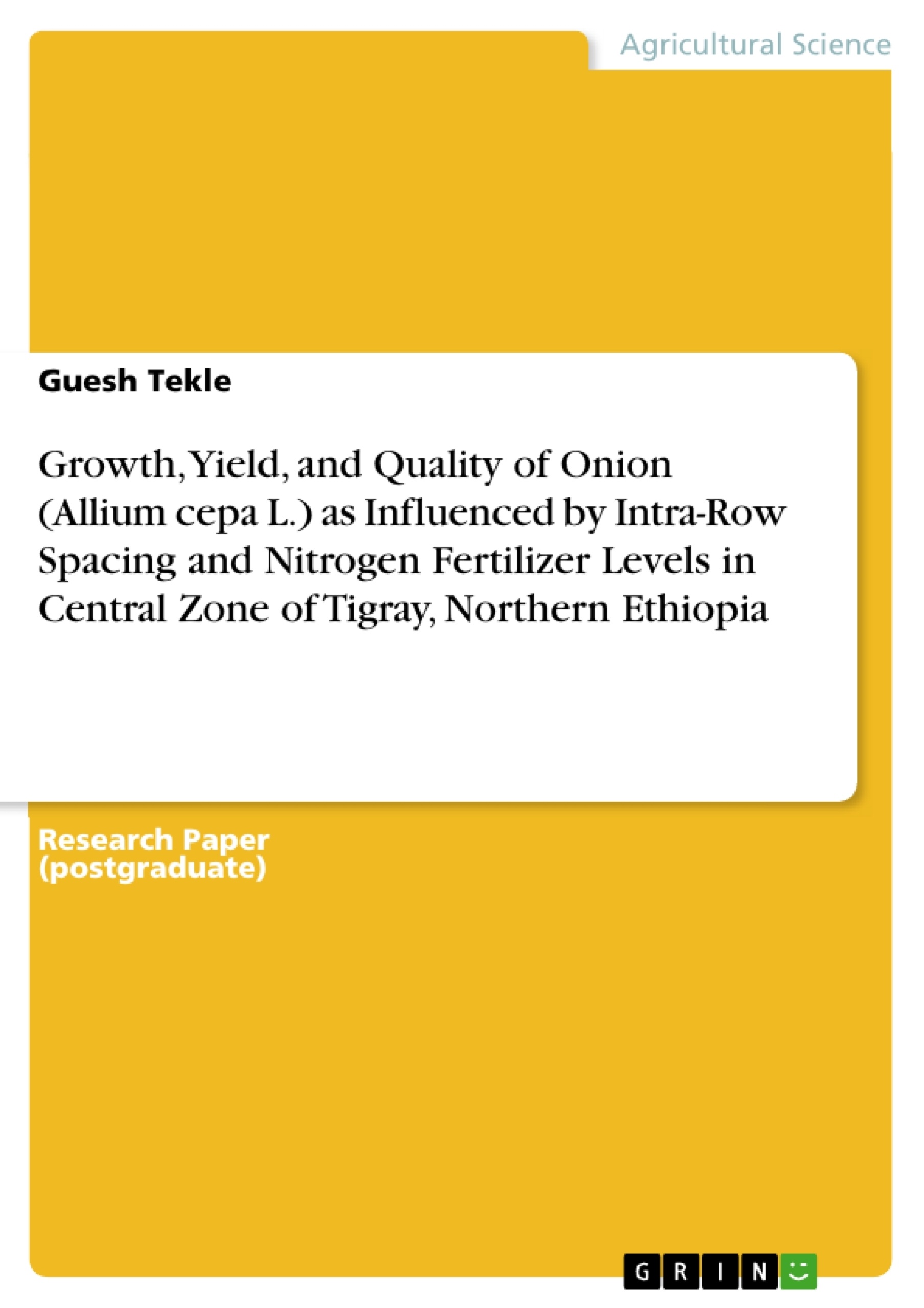Haphazard and inappropriate plant spacing and poor soil fertility management practices are among the major factors constraining onion production in the Central Zone of Tigray. Therefore, a field experiment was conducted in Axum district from October to March 2014 to assess the influence of intra-row spacing (2.5, 5, 7.5, 10 and 12.5 cm) and nitrogen rate (0, 41, 82 and 123 kg N ha-1) on growth, bulb yield, and quality of onion. The experiment was laid out in a randomized complete block design (RCBD) of factorial arrangement with three replications. The main effects of nitrogen rate and intra-row spacing influenced only the plant height and stand count significantly (P < 0.01). The tallest plants (46.70 cm) were obtained from plants treated with 82 kg N ha-1 as well as those spaced at 7.5 cm intra-row spacing (43.78 cm). The highest stand count (90.33%) at harvest was recorded from plots that received 82 kg N ha-1 and spaced at 12.5 cm (98.04%). Nitrogen rate and intra-row spacing interacted to significantly (P < 0.01) to influence all parameters. Thus, increasing the rate of nitrogen across the increasing intra-row spacing significantly prolonged days to maturity, enhanced average bulb weight, bulb diameter, bulb neck diameter, leaf number per plant, leaf diameter, shoot dry matter, and dry total biomass yield. In general, the highest values of these parameters (126.67, 123.85 g, 6.05 cm, 1.35 cm, 12.57, 1.38 cm, 3.22 g and 13.08 g, respectively) were attained in response to the application of 123 kg N ha-1 and 12.5 cm intra-row spacing. However, their least values (100, 23.99 g, 2.33 cm, 0.68 g, 6.60, 0.47 cm, 0.73 g, and 2.72 g, respectively) were obtained at 0 kg N ha-1 and 2.5 cm intra-row spacing. The highest value of bolting (31.95%) was observed from the application of 0 kg N ha-1 and plant spacing of 2.5 cm. Increasing the N rate across the increasing intra-row spacing increased the yields of over-sized bulbs whereas decreasing the yields of small-sized, under-sized bulbs and unmarketable bulb yield. The highest yield of over-sized bulbs (4.03 t ha-1) was recorded at 123 kg N ha-1 and the intra-row spacing of 12.5 cm.
Inhaltsverzeichnis (Table of Contents)
- Introduction
- Materials and Methods
- Study Area
- Experimental Design and Treatments
- Crop Management Practices
- Data Collection and Analysis
- Results and Discussion
- Effect of Intra-row Spacing and Nitrogen Fertilizer Levels on Plant Height
- Effect of Intra-row Spacing and Nitrogen Fertilizer Levels on Bulb Yield
- Effect of Intra-row Spacing and Nitrogen Fertilizer Levels on Bulb Diameter
- Effect of Intra-row Spacing and Nitrogen Fertilizer Levels on Bulb Weight
- Effect of Intra-row Spacing and Nitrogen Fertilizer Levels on Harvest Index (HI)
- Effect of Intra-row Spacing and Nitrogen Fertilizer Levels on Total Soluble Solids (TSS)
- Conclusion
Zielsetzung und Themenschwerpunkte (Objectives and Key Themes)
This thesis aims to investigate the effects of intra-row spacing and nitrogen fertilizer levels on the growth, yield, and quality of onion (Allium Cepa L.) in the Central Zone of Tigray, Northern Ethiopia. The study also evaluates the economic viability of onion production under different intra-row spacing and nitrogen fertilizer treatments. The findings of this research will help farmers optimize onion production practices in the region and enhance their livelihoods.
- Impact of intra-row spacing on onion growth, yield, and quality
- Influence of nitrogen fertilizer levels on onion growth, yield, and quality
- Economic analysis of onion production under different treatments
- Optimization of onion production practices in the Central Zone of Tigray
- Contribution to the sustainable development of onion production in Northern Ethiopia
Zusammenfassung der Kapitel (Chapter Summaries)
The introductory chapter provides a comprehensive overview of onion production, its importance in Ethiopia, and the research objectives. It also highlights the significance of intra-row spacing and nitrogen fertilization in onion cultivation.
The second chapter details the materials and methods employed in the study, including the study area, experimental design, treatments, crop management practices, data collection techniques, and statistical analysis. The experimental setup and methodology are meticulously described to ensure the reproducibility of the research.
The third chapter presents the results and discussion of the research findings. It analyzes the effects of intra-row spacing and nitrogen fertilizer levels on various growth parameters, yield components, and quality attributes of onion. The chapter also explores the economic feasibility of different treatment combinations.
Schlüsselwörter (Keywords)
Onion, Allium Cepa L., intra-row spacing, nitrogen fertilization, growth, yield, quality, harvest index, total soluble solids, economic analysis, Tigray, Ethiopia
- Citation du texte
- Guesh Tekle (Auteur), 2018, Growth, Yield, and Quality of Onion (Allium cepa L.) as Influenced by Intra-Row Spacing and Nitrogen Fertilizer Levels in Central Zone of Tigray, Northern Ethiopia, Munich, GRIN Verlag, https://www.grin.com/document/454821



